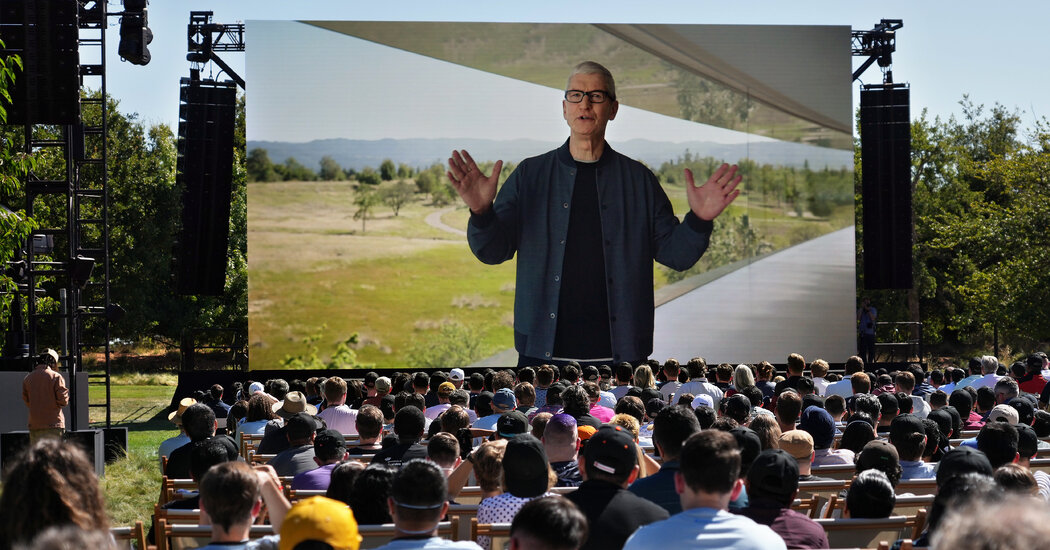
CUPERTINO, Calif. — More than two years into the coronavirus pandemic, Apple made a big push on Monday to return to normalcy by inviting hundreds of software developers and journalists to its campus for an unveiling of a range of new software features that expand the iPhone’s utility.
Over a two-hour presentation, Apple revealed a buy-now-pay-later program that splits a purchase over several months, much like programs offered by PayPal and others. It also said it was expanding the ability to use an iPhone to unlock doors to apartments, hotel rooms and rental cars. And it introduced a version of CarPlay that would take over a vehicle’s entire dashboard, providing speed and fuel information as well as maps and music.
Collectively, the new features show how Tim Cook, the chief executive, is still finding ways to expand the usefulness and longevity of Apple’s most important product while wringing more sales out of it through features that thrust the company deeper into adjacent industries such as finance, real estate and autos.
“They are the digital control center, and they are extending their reach as more and more devices are digitized,” said Bob O’Donnell, president of TECHnalysis Research, a firm specializing in tech research. “Much of this is not going to change the world, but they are enhancements that give a little freshness that people appreciate.”
The software updates continue a yearslong lull in the introduction of a new product category from a company that its co-founder Steve Jobs made synonymous with revolutionary new devices. Apple last unveiled a new product category, wearables, in 2014 when it introduced the Apple Watch.
Read More About Apple
The pandemic has helped increase sales of Apple’s legacy products. Students and employees forced to work from home found value in upgrading to the latest versions of its iPhones, iPads and Mac computers. Many turned to video games and subscriptions for Apple TV+, helping increase the company’s sales last year by 33 percent to $366 billion.
On Monday, Apple looked to further the momentum of its Macs by updating its most popular computer, the MacBook Air. The new version sheds a decade-old wedge-shaped case in favor of a slender, rectangular laptop. The computer comes in a multitude of colors, including silver, space gray, gold and dark blue. The new model is 20 percent smaller than its predecessor and weighs 2.7 pounds, the company said.
The MacBook Air features Apple’s newest processor, the M2, which the company said offered increased performance even as it required less battery power.
The company said it was bringing more personalization to the iPhone, with the ability to customize the lock screen with colors, widgets and live activities. The new software will let iPhone users create custom lock screens for different purposes — like a screen for work that shows a preview of a calendar, or a personal screen that shows exercise activity data.
The new software features, part of Apple’s new iOS 16 operating system for iPhones, mirrored those that Google introduced for its Android system in 2021. Google created Material You, an offering that allows users to change the look of their lock screens by pulling from colors in their home screen wallpapers.
In addition to those updates, Apple said it was overhauling its messaging system, allowing people to recall and edit texts after sending them. There also is a new ability to compose messages by fluidly switching between typing text and dictating voice memos.
The company’s efforts to push beyond its existing businesses extended to new software for the iPad. It showcased new tools for workplace collaboration called Freeform, which allows colleagues to brainstorm across devices at the same time. The feature, similar to offerings from Microsoft and Google, has the potential to increase the iPad’s value to businesses.
Apple also unveiled software updates to its smartwatch that will allow runners to monitor their gait — potentially forgoing work with trainers — and help people track the stages of their sleep cycle.
The presentation was the first major event Apple has hosted on its campus in Cupertino since 2019. In light of rising coronavirus cases in the Bay Area, the company set up screens and chairs outside the cafeteria at the heart of its $5 billion campus, Apple Park. Attendees included developers, journalists and retail employees, a group that Apple is eager to improve relations with amid a rise in union organizing.
Though the event focused on existing products, it sprinkled hints of a virtual reality product that the company hopes will be its next business-altering device. Apple said it was making it easier for apps to use Siri, creating a shortcut that will make it possible to interact with apps through voice in future headsets, a person familiar with the project said. It also showed a demonstration of a new Resident Evil video game with the kind of sophisticated graphics customary in virtual reality games.
The headset, which looks like a pair of ski goggles, is not expected to ship until next year because of challenges with battery power and performance, two people familiar with the project said.
Its success is far from guaranteed. Meta, Facebook’s parent company, has struggled to broaden the appeal of its Quest virtual reality headset beyond avid video game players. Last year, it surpassed about 10 million unit sales, a small fraction of the 240 million iPhones that analysts estimate Apple shipped.
Apple has struggled to persuade developers to embrace its vision of a mixed reality world. In 2017, it introduced ARKit to allow developers to use the iPhone’s camera and motion sensor to begin blending the digital and real worlds. But about 70 percent of Apple’s developers said they did not use the tool, according to a survey of more than 500 developers by Creative Strategies, a technology research firm.




